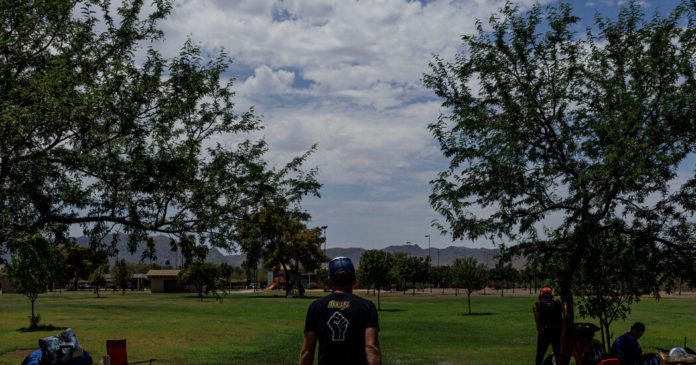“Like being on the edge of death if you go for a walk.”
That’s how my colleague Jack Healy described living in Phoenix, where it has reached 110 degrees Fahrenheit (43 degrees Celsius) or higher for 13 consecutive days, with no end in sight.
Jack moved to Phoenix in 2021, chasing stories about the fast-growing American West. And this week, he filed a remarkable article about the withering heat wave currently scorching the Southwest.
He wrote: “Summers in Phoenix are now a brutal endurance match. As the climate warms, forecasters say that dangerous levels of heat crank up earlier in the year, last longer — often well past Halloween — and lock America’s hottest big city in a sweltering straitjacket.
“In triple-digit heat, monkey bars singe children’s hands, water bottles warp and seatbelts feel like hot irons. Devoted runners strap on headlamps to go jogging at 4 a.m., when it is still only 90 degrees, come home drenched in sweat and promptly roll down the sun shutters. Neighborhoods feel like ghost towns at midday, with rumbling rooftop air-conditioners offering the only sign of life.”
Jack talked to a mail carrier named Rachelle Williams, who moved to Phoenix to escape Midwestern winters. No matter how much water she drinks or sun protection she wears, her legs tingle and head spins as she covers her route.
“I don’t even know how I do it,” she said. A community volunteer, who distributes water and ice to people in need, said the heat feels like “walking around in a blow-dryer.”
Jack knows he’s lucky. He has a job that allows him to spend time in air-conditioning. Nevertheless, he’s had to develop his own coping strategies for living in an open-air furnace.
He starts drinking water the moment he wakes up, “to saturate your system.” He wears long sleeves and pants “to guard against the sun and the reflected heat from the pavement.” He freezes water bottles and takes them everywhere, “drinking them down as they slowly melt.” And he always has electrolytes on hand to replace the salts that he sweats out.
One key part of living in Phoenix, Jack told me, is “learning to accept and live with being extraordinarily sweaty all the time.”
An over-baked world
The experience of Jack and his fellow Phoenicians is increasingly common. California is bracing for a heat wave with triple-digit temperatures. Heat advisories are in effect from the Central Plains to South Florida this week. In Texas, 10 residents of Laredo died from heat-related illnesses between June 15 and July 3.
“People are used to being without air conditioning, surviving without air conditioning,” the city’s medical examiner told my colleague David Goodman. “But it was just too hot, and we lost a lot of people because of it.”
Around the globe, temperatures are soaring as the world enters a multiyear period of intense warming, fueled by man-made climate change and a naturally occurring El Niño weather pattern, which is releasing a gusher of heat into the atmosphere.
This week, temperatures are approaching 110 degrees Fahrenheit in Seville, Spain; Riyadh, Saudi Arabia; and Marrakesh, Morocco. In places like Kuwait City and Basra, Iraq, it’s not uncommon for the heat index (a combination of air temperature and humidity) to reach 125 degrees in the morning, The Times reported last year.
And just last week, my colleagues in Mexico had a story about what it’s like to live in one of that country’s hottest cities, Hermosillo, where a 120-degree day is not uncommon.
But the risks of heat extend well beyond those cities that regularly rank as the hottest in the world. As Somini Sengupta wrote in this newsletter in April, “extreme heat can be deceptively dangerous, even in places accustomed to extreme heat.”
“It’s not just Texas and Southern California and Florida. That’s not the full picture,” said Dr. Kai Chen, a professor at the Yale School of Public Health who studies the health risks from climate change. “People are vulnerable everywhere.”
Dr. Chen and his colleagues recently unveiled an interactive map of the U.S. that shows how vulnerable different parts of the country are to extreme heat.
Their research revealed that people in Costilla County, Colo.; Marion County, Ind.; and Essex County, Mass., are also at high risk from boiling temperatures as heat waves affect more and more of the country.
Dr. Chen and his team considered factors such as income and education level, as well as how much green space neighborhoods have and whether people live alone.
Unfortunately and unsurprisingly, their research showed that in wealthier neighborhoods — where people are more likely to have air-conditioning and do less work outdoors — the risks from extreme heat were less severe. In neighborhoods with lower incomes and fewer trees, the risks skyrocketed.
“What we found is that for people who have low socioeconomic status, especially minorities, the health risks of heat are much higher,” Dr. Chen said.
Whether you’re in Phoenix, Baghdad or New York, it’s important to know how to stay cool, stay hydrated and watch for signs of heat stress and heat stroke. All of that and more is explained in this helpful guide to dealing with a heat wave.
Beating heat with the whitest white
The whitest paint ever is in the Guinness Book of World Records, but that’s not its greatest achievement.
The paint, created by scientists at Purdue University, cools down buildings by bouncing 98 percent of the sun’s rays away from the Earth’s surface, up through the atmosphere and into deep space.
It doesn’t look all that different from regular white paint from the hardware store, which absorbs significant heat from the sun. By comparison, the Purdue paint cools surfaces to below-ambient temperatures — by up to eight degrees Fahrenheit during the day, and 19 degrees at night. That could reduce air-conditioning usage and help power grids struggling to cope with heat waves, as the paint doesn’t need any energy to work.
Using the ultra-reflective paint, which is at least a year from being ready for commercial use, could help offset the urban heat island effect. But there are limits to this type of cooling. We still need to stop sending greenhouse gasses into the atmosphere to avoid more catastrophic warming, according to Jeremy Munday, a clean technology expert.
“This is definitely not a long-term solution to the climate problem,” he told my colleague Cara Buckley. “This is something you can do short term to mitigate worse problems while trying to get everything under control.”
— Manuela Andreoni
Other climate news
The weather report
A heat dome of high pressure over the Southwest will strengthen into the weekend, raising temperatures to well above 100 degrees Fahrenheit from portions of California to Texas. While the air will be dry, temperatures could reach record heat values, creating an extreme risk of heat-related illness.
The area of sweltering temperatures will expand Friday, particularly over the northwest section of the country. From eastern Texas through the Southeast and into Florida, humidity may make temperatures feel as hot as 105 to 115 degrees, and possibly higher.
Coastal states in the South will experience above-average temperatures combined with high humidity, made worse by unusually warm waters in the Gulf of Mexico and the western Atlantic Ocean, creating dangerous conditions, especially along the coasts from South Texas to the Carolinas.
Urban areas can often be several degrees hotter than surrounding areas, with less relief at night. The heat is expected to persist into next week, and may expand further east and north.
—Judson Jones and Camille Baker
Source : Nytimes












